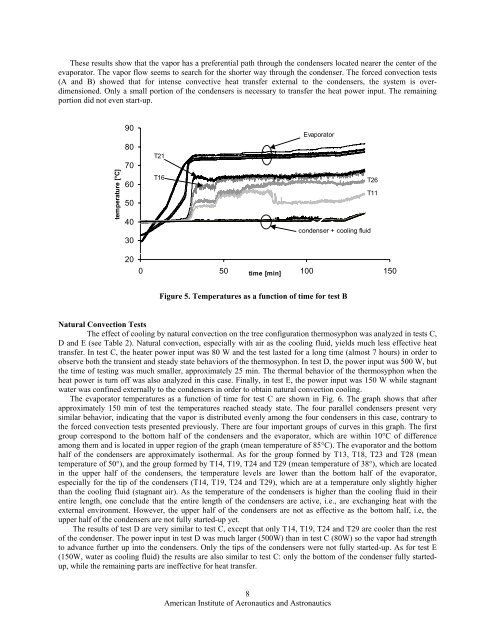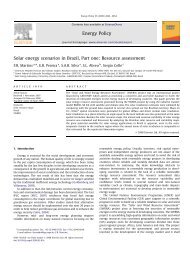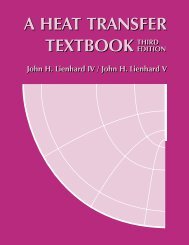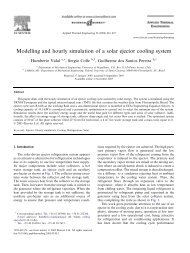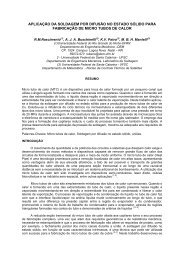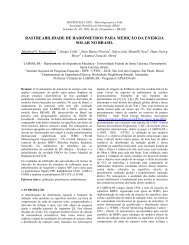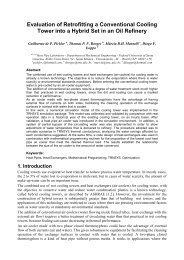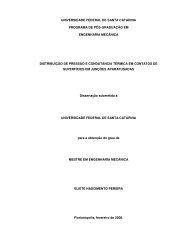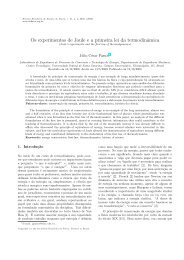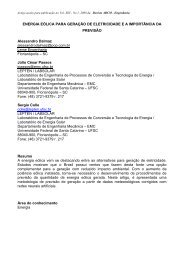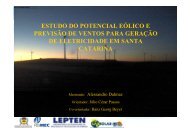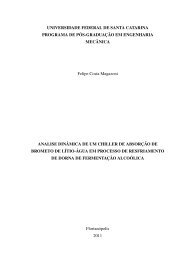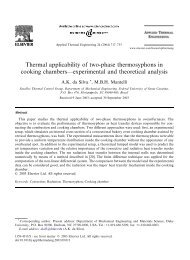Tree Configuration Thermosyphon Study - LEPTEN
Tree Configuration Thermosyphon Study - LEPTEN
Tree Configuration Thermosyphon Study - LEPTEN
You also want an ePaper? Increase the reach of your titles
YUMPU automatically turns print PDFs into web optimized ePapers that Google loves.
These results show that the vapor has a preferential path through the condensers located nearer the center of the<br />
evaporator. The vapor flow seems to search for the shorter way through the condenser. The forced convection tests<br />
(A and B) showed that for intense convective heat transfer external to the condensers, the system is overdimensioned.<br />
Only a small portion of the condensers is necessary to transfer the heat power input. The remaining<br />
portion did not even start-up.<br />
temperature [°C]<br />
90<br />
80<br />
70<br />
60<br />
50<br />
40<br />
30<br />
T21<br />
T16<br />
Evaporator<br />
T26<br />
T11<br />
condenser + cooling fluid<br />
20<br />
0 50 100 150<br />
time [min]<br />
Figure 5. Temperatures as a function of time for test B<br />
Natural Convection Tests<br />
The effect of cooling by natural convection on the tree configuration thermosyphon was analyzed in tests C,<br />
D and E (see Table 2). Natural convection, especially with air as the cooling fluid, yields much less effective heat<br />
transfer. In test C, the heater power input was 80 W and the test lasted for a long time (almost 7 hours) in order to<br />
observe both the transient and steady state behaviors of the thermosyphon. In test D, the power input was 500 W, but<br />
the time of testing was much smaller, approximately 25 min. The thermal behavior of the thermosyphon when the<br />
heat power is turn off was also analyzed in this case. Finally, in test E, the power input was 150 W while stagnant<br />
water was confined externally to the condensers in order to obtain natural convection cooling.<br />
The evaporator temperatures as a function of time for test C are shown in Fig. 6. The graph shows that after<br />
approximately 150 min of test the temperatures reached steady state. The four parallel condensers present very<br />
similar behavior, indicating that the vapor is distributed evenly among the four condensers in this case, contrary to<br />
the forced convection tests presented previously. There are four important groups of curves in this graph. The first<br />
group correspond to the bottom half of the condensers and the evaporator, which are within 10°C of difference<br />
among them and is located in upper region of the graph (mean temperature of 85°C). The evaporator and the bottom<br />
half of the condensers are approximately isothermal. As for the group formed by T13, T18, T23 and T28 (mean<br />
temperature of 50°), and the group formed by T14, T19, T24 and T29 (mean temperature of 38°), which are located<br />
in the upper half of the condensers, the temperature levels are lower than the bottom half of the evaporator,<br />
especially for the tip of the condensers (T14, T19, T24 and T29), which are at a temperature only slightly higher<br />
than the cooling fluid (stagnant air). As the temperature of the condensers is higher than the cooling fluid in their<br />
entire length, one conclude that the entire length of the condensers are active, i.e., are exchanging heat with the<br />
external environment. However, the upper half of the condensers are not as effective as the bottom half, i.e, the<br />
upper half of the condensers are not fully started-up yet.<br />
The results of test D are very similar to test C, except that only T14, T19, T24 and T29 are cooler than the rest<br />
of the condenser. The power input in test D was much larger (500W) than in test C (80W) so the vapor had strength<br />
to advance further up into the condensers. Only the tips of the condensers were not fully started-up. As for test E<br />
(150W, water as cooling fluid) the results are also similar to test C: only the bottom of the condenser fully startedup,<br />
while the remaining parts are ineffective for heat transfer.<br />
8<br />
American Institute of Aeronautics and Astronautics


